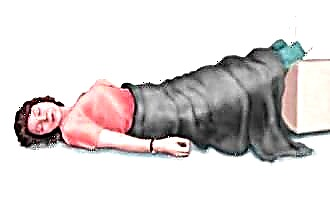With maxillary sinusitis, an inflammatory process develops in one or both paranasal sinuses. At the same time, it is often difficult to determine at the very beginning that it is sinusitis, and not a common cold or runny nose. In order not to start the disease, you need to start treatment of catarrhal sinusitis immediately, then there is a chance to avoid its purulent form. In this case, physiotherapy, medicines and traditional medicine are used.
What are the signs of the initial stage of sinusitis
 Almost always, sinusitis begins with a catarrhal stage, in which the mucous membranes of the nasal cavity and the connecting canals swell, complicating the drainage of the accessory chambers. At the same time, the bacterial microflora has not yet joined, therefore, purulent phenomena are not observed. This form of sinusitis is defined as mild and can be cured without the use of strong medications. The main condition for this is to start the necessary therapeutic measures in a timely manner. In children, the catarrhal form is more common than in adults due to the susceptibility of the mucous membrane to edema, even with small changes in the microclimate.
Almost always, sinusitis begins with a catarrhal stage, in which the mucous membranes of the nasal cavity and the connecting canals swell, complicating the drainage of the accessory chambers. At the same time, the bacterial microflora has not yet joined, therefore, purulent phenomena are not observed. This form of sinusitis is defined as mild and can be cured without the use of strong medications. The main condition for this is to start the necessary therapeutic measures in a timely manner. In children, the catarrhal form is more common than in adults due to the susceptibility of the mucous membrane to edema, even with small changes in the microclimate.
It is possible to determine that catarrhal maxillary sinusitis develops in the body by the following characteristic signs:
- persistent runny nose for several days, while the amount of discharge only increases;
- the mucus becomes thicker and takes on a greenish tint;
- nasal breathing is difficult, congestion appears;
- body temperature rises to 37.5-38 degrees;
- there is a mild sensation of pressure under the eyes and in the cheekbones, especially in an inclined state;
- general state of health: lethargy, headache, muscle aches, low efficiency;
- swelling of the face and lower eyelids is possible;
- sometimes a burning or itching sensation in the nose.
If symptoms appear on one side of the face, then right-sided or left-sided sinusitis can be suspected, if on both, then bilateral. The impetus for the onset of the disease can be acute respiratory infections or acute respiratory viral infections, rhinitis (cold or allergic), infectious diseases in the nasal cavity, facial trauma. Symptoms and treatment of sinusitis depend on the cause of the development of the disease.
Home remedies for sinusitis
At the first sign of sinusitis, it is better to consult an otolaryngologist to find out how to treat catarrhal sinusitis. However, this is not always possible, therefore, before visiting the doctor, you can begin to carry out procedures for sanitizing the nasal cavity and relieving symptoms. On examination, the doctor can confirm the diagnosis and prescribe outpatient therapy.
With catarrhal sinusitis, treatment at home is carried out in the following main directions:
- creating conditions for the unimpeded outflow of secretions from the air pockets and the nasal cavity;
- cleansing the nasal passages by rinsing them;
- relief of the inflammatory process and ensuring the normal functioning of the epithelial layer of the mucous membrane using inhalations, drops and ointments;
- liquefaction of mucus by using various mucolytic agents, compresses;
- warming up the sinuses with dry heat.
Let us dwell in more detail on the question of how to treat sinusitis at home. In fact, therapy is a lot like treating a common cold.
Cleansing of accessory pockets and nasal passages
It is possible to relieve puffiness and free passages for the outflow of mucus with the help of vasoconstrictor drugs (decongestants). They are available as sprays and topical drops. Depending on the active ingredient, the effect of different drugs has its own characteristics:
- Naphazoline. An inexpensive tool that has been used for a long time. It begins to act quickly and helps within 5-8 hours. The disadvantages include irritating effect on the nasal mucous membranes. In children, it can sometimes reduce the activity of the nervous system, so it is not recommended at an early age. Known drugs: Sanorin, Naphthyzin.
- Phenylephrine Its action is limited to 2-4 hours, it is less active, therefore it is more often used in pediatrics. At the same time, it is undesirable to exceed the dose established by the doctor, since in children there is an increased absorption of phenylephrine. Both a child and an adult should not use such drops for more than 3 days. Nazol Baby for kids and Nazol Kids for kids from 6 years old are on sale.
- Xylometazoline. Widely distributed in aerosols and drops. Unlike naphazoline, it has a negative effect on mucous membranes only if it is used for a long time (over several weeks). It is used to treat children from birth (concentration 0.05%) and adults (0.01%). The pharmacies offer Otrivin, Galazolin, Tizin, Xymelin.
- Oxymetazoline. Alpha-adrenergic agonist, in its action is similar to xylometazoline. It works up to 8 hours, although after instillation you need to wait 15 minutes. It is produced in three concentrations: 0.01% - for babies up to a year, 0.025% - for babies up to 6 years old, 0.05% - for all patients from 6 years of age. Preparations: Nazol, Nazivin.
- Tramazoline. One of the newest developments of pharmacologists. The action begins in 5 minutes and lasts up to 10 hours. The epithelium is not irritated due to the mild action of the drug. The disadvantage is the high price. Medicine - Lazolvan Reno.
 To soften the action of decongestants and enhance the bactericidal effect, essential oils (eucalyptus, mint) are added to their composition. You need to pay attention to this nuance when buying, because some people have an individual intolerance to herbal remedies. Also, combined drugs are produced, containing, in addition to the vasoconstrictor component, also an antihistamine (for example, Vibrocil).
To soften the action of decongestants and enhance the bactericidal effect, essential oils (eucalyptus, mint) are added to their composition. You need to pay attention to this nuance when buying, because some people have an individual intolerance to herbal remedies. Also, combined drugs are produced, containing, in addition to the vasoconstrictor component, also an antihistamine (for example, Vibrocil).
It is not recommended to drip decongestants into the nose for more than 7 days in order to avoid vascular fragility and the development of bleeding. If there is a need for their further use, then you need to use a product with another active substance.
Rinsing the nose for sinusitis
After removing the edema, it is necessary to liquefy the mucous masses and remove them from the sinuses and nasal cavity. For this, rinsing the nasal cavity with saline solutions or decoctions of medicinal plants is used. Washing is a simple procedure that can be done at home, you just need to know how to do it correctly.
You can rinse your nose with 0.9% saline solution, you can make it at home by diluting half a teaspoon of rock salt in a glass of boiled warm water. There are sometimes added 2 drops of iodine or a couple of crystals of potassium permanganate. Treatment with folk remedies also helps, in particular, decoctions of medicinal plants (one tablespoon of chopped dry herb per glass of boiling water). A stronger antimicrobial effect can be provided by drugs such as Miramistin and Furacilin.
At home, the usual flowing rinsing is performed. The patient bends over the sink. Water is supplied under slight pressure into one nostril, and then, passing through the entire nasal cavity and capturing mucus, flows out through the other. For infusion of liquid, a syringe, syringe or a special teapot from yoga practice is used.
It is not necessary to create strong pressure, as infected water can leak into the ear through the Eustachian tube and cause otitis media, especially in children.
It is convenient to rinse your nose yourself using pharmacy solutions based on sea water or sea salt with biologically active additives (Aqua Maris, Humer, Dolphin). In addition to a balanced chemical composition, they are distinguished by the presence in the set of convenient accessories for washing. Irrigation should be done at least 3 times a day.
An important question is the correct blowing of your nose.You need to blow out each nostril in turn, pinching the other with your finger. If you blow out a secret from both moves at the same time, then mucus can get into the auditory tube. Severe tension when blowing out the nose often leads to painful sensations or rupture of the vessel wall, followed by bleeding.
Normalization of the mucous membrane and warming up
 Various methods can be used to relieve inflammation and ensure the full functioning of the ciliated epithelium, relieve symptoms and restore nasal breathing, without going to the hospital every time. The most common methods are steam inhalation, the use of drops and ointments in the nose.
Various methods can be used to relieve inflammation and ensure the full functioning of the ciliated epithelium, relieve symptoms and restore nasal breathing, without going to the hospital every time. The most common methods are steam inhalation, the use of drops and ointments in the nose.
Inhalation is good for clearing the nasal passages, thinning mucus, and improving breathing through the nose. The patient breathes in steam by leaning over a saucepan and covering his head with a towel or blanket. It is important to be careful not to burn yourself with boiling water or burn the mucous membrane. You need to breathe evenly and deeply, if the condition worsens, immediately interrupt the procedure. Individuals in your city, prostitutes of sochi. Intimate rest for men. Inhalations are carried out daily, after which it is undesirable for a person to go outside so as not to get cold.
Several common home inhalation recipes:
- A few peeled potatoes are boiled until tender, then the water is drained, and the potatoes are slightly kneaded. The patient breathes in steam for 10-15 minutes.
- 2 teaspoons of propolis alcohol tincture 10% (sold in every pharmacy) is poured into 2 liters of boiling water. This recipe is not suitable for children and people with intolerance to bee waste products.
- 3 tablespoons of herbal collection of sage, yarrow, chamomile, St. John's wort and a series of brew in 2 liters of boiling water. Carry out inhalations 4 times a day in the evenings every hour.
- 15 drops of alcoholic tincture of eucalyptus are added to a liter of boiling water, breathe for 5-10 minutes.
Nasal drops are prepared from natural raw materials that can be easily found in the store or at home. They are poured into the nose 3-4 times a day, 2-3 drops each. Proven folk recipes:
- Fresh cyclamen root is grated and squeezed through cheesecloth. A teaspoon of juice is diluted in boiled water and dripped into the nose in 2 drops. The result is an active discharge of mucus. Care must be taken when working with undiluted plant sap, as it is a strong poison.
- Mix equal parts of honey and aloe juice with 4 g of celandine. Infuse 5 times a day, 3 drops.
- Combine bee honey dissolved in a water bath with onion and potato juice in equal proportions. Apply for nasal congestion.
Another reliable tool is all kinds of compresses that are applied to the area of the accessory chambers:
- Rub the black radish fruit on a fine grater, wrap it in a cloth or handkerchief and put it on the cheekbone or in the region of the nose. Repeat for a week, 3 times a day.
- Onion. The onion is pounded with the peel, squeezed out a little and wrapped in gauze or cloth. The skin where this compress is applied is pre-lubricated with cream to prevent burns. The eyes are closed with a handkerchief or cotton pads, otherwise irritation and watery eyes may occur.
- Bay leaf. A few leaves are boiled for 5 minutes, cooled a little. Moisten the napkin in the broth and put it on the face in the sinus area until it cools down, covering it with a towel. Repeat several times in a row.
Heating the chambers with dry heat is also effective. To do this, use a blue lamp (Minin's reflector) or hard-boiled chicken eggs.
The main thing is not to warm up the sinuses during the development of a purulent process, this can intensify the symptoms of the disease.



